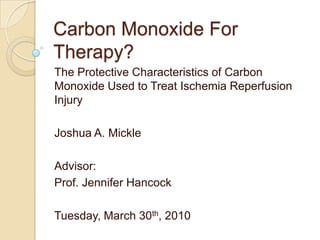
CO Therapy Reduces Ischemia Reperfusion Injury
- 1. Carbon Monoxide For Therapy? The Protective Characteristics of Carbon Monoxide Used to Treat Ischemia Reperfusion Injury Joshua A. Mickle Advisor: Prof. Jennifer Hancock Tuesday, March 30th, 2010
- 2. Background Ischemia reperfusion injury (IRI) Damage caused by the occlusion and subsequent return of blood supply to tissue http://hyperbaricworx.com.au/images/How2.png
- 3. Why does reperfusion cause damage? Combination of factors Local and systemic inflammatory response Leukocyte activation Adherence to vessel walls Transmigration to interstitial space Increased edema, clotting, permeability Collard & Gelman, 2001, 1134
- 4. Why does reperfusion cause damage? Reperfusion Large influx of O2
- 5. What is Carbon Monoxide (CO)? Colorless, odorless, poisonous gas CO greater affinity than O2 for Hemoglobin Hb Unable to deliver O2 Disrupts cell respiration and triggers hypoxia http://www.jems.com/Images/CO_Fig1_tcm16-186547.jpg
- 6. Why use CO for treatment? CO produced naturally in body Heme Oxygenase-1 system (HO-1) HO-1 converts heme molecule into CO, iron, and biliverdin http://www.bioscience.org/2007/v12/af/2130/figures.htm
- 7. Why use CO for treatment? Oxidative stress shows increase in HO-1 Leads to increase in CO concentration in blood Possibly a mechanism of protection against reactive oxygen species Availability Relatively well-understood toxicology LOW CONCENTRATIONS
- 8. Current Treatments for IRI Ischemic preconditioning Therapeutic hypothermia Anti-leukocyte therapy Introducing radical scavengers and antioxidants Treatment of symptoms following damage
- 9. Hypothesis CO therapy is a viable option for further investigation and eventual use on humans alongside or replacing the current treatment options for IRI.
- 10. CO Treatment Following Stroke Stroke induced on rats (Zeynalov E, Dore`, 2008) 90 min. occlusion of Middle Cerebral Artery Moore & Dalley, 2006, 929
- 11. CO Treatment During reperfusion subjected to various concentrations of CO exposed at 0, 1, or 3 hrs following reperfusion 125ppm At 0h 250ppm At 0h Air At 0h 250ppm At 1h All for 18h of total exposure 250ppm At 3h
- 12. Analysis of Recovery Neurological Deficit Scores (NDS) Conducted at: Onset of reperfusion 24hrs 48hrs Scores range from 0 – 4 Good Bad
- 13. Results
- 14. Also Analyzed Brain tissue Sliced into 2mm sections Stained to show metabolic activity Anterior Posterior
- 15. Also Analyzed Brain Edema Ipsilateral and contralateral hemispheres separated % Brain Water = [(Wet – Dry)/Wet] x 100
- 16. Not only in the Brain CO treatment in rat heart transplant model Akamatsu et al., 2004 Comparison of CO therapy during reperfusion to: HO-1 activation Air inhalation
- 17. Procedures Heart transplant Success/failure – % survival CO Exposure Varying exposure to donor, graft, and/or recipient 400ppm
- 19. Results Highest survival rate Donor and graft exposure Donor, graft, and recipient exposure Interesting to note Donor and Recipient exposure only
- 20. Other studies Similar results in liver and lung grafts Both in vivo and ex vivo (Amersi et al., 2002; Kohmoto et al., 2006) Upregulation of HO-1 system Increases CO endogenously (Amersi et al., 1999) Current goal Investigate mechanisms behind these results
- 21. Limitations to current studies Small sample sizes Small animal models (rats and mice) Performed only on healthy specimens Although better, still low survival rate Need to improve before human trials Long term effects Dosage and duration of CO treatment
- 22. Contradiction among studies Mechanisms of action Anti-inflammatory Anti-apoptotic Other HO-1 byproducts
- 23. Conclusions & Implications Compared to no IRI treatment: CO therapy shows significantly improved tissue functioning Promising for future treatments of IRI Must further understand mechanism before clinical implementation
- 24. References Akamatsu Y, Haga M, Tyagi S, Yamashita K, Graca-Souza AV, Ollinger R, Czismadia E, May GA, Ifedigbo E, Otterbein LE, Bach FH, Soares MP. 2004. Heme- oxygenase-1-derived carbon monoxide protects hearts from transplant- associated ischemia reperfusion injury. The FASEB Journal. 18: 771-782. Amersi F, Shen X, Anselmo D, Melinek J, Iyer S, Southard D J, Katori M, Volk H, Busuttil R W, Buelow R, Kupiec-Weglinski J W. 2002. Ex-vivo exposure to carbon monoxide prevents hepatic ischemia/reperfusion injury through p38MAP Kinase pathway. Hepatology. 35(4): 815-823. Amersi F, Buelow R, Kato H, Ke B, Coito AJ, Shen X, Zhao D, Zaky J, Melinek J, Lassman CR, Kolls JK, Alam J, Ritter T, Volk HD, Farmer DG, Ghobrial RM, Busuttil RW, Kupiec-Wegelski JW. 1999. Upregulation of heme oxygenase-1 protects genetically fat Zucker rat livers from ischemia/reperfusion injury. The Journal of Clinical Investigation. 104(11): 1631-1639. Kohmoto J, Nakao A, Kaizu T, Tsung A, Ikeda A, Tomiyama K, Billiar TR, Choi AMK, Murase N, McCurry KR. 2006. Low-dose carbon monoxide inhalation prevents ischemia/reperfusion injury of transplanted rat lung grafts. Surgery. 140(2): 179-185. Zynalov E, Doré S. 2009. Low doses of carbon monoxide protect against experimental focal brain ischemia. Neurotoxicity Research. 15(2): 133-137.
- 25. Acknowledgements Prof. Hancock Dr. Brown Capstone Classmates Teammates
- 26. Questions?